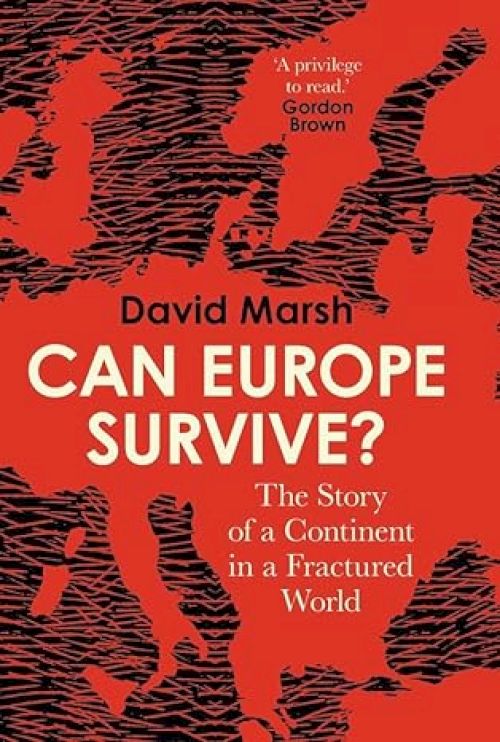10 November 2025
Can Europe Survive?
The Story of a Continent in a Fractured World
David Marsh
2025, Yale University Press, 528 pages,
ISBN 9780300273007
Reviewer: Ian Harwood

Many readers will be familiar with veteran journalist and commentator David Marsh’s superbly insightful Europe-focused previous publications. This latest oeuvre, the author tells us, “started gestation in 2021 as a relatively modest update on the development of the European single currency but … it quickly broadened and deepened”. So much so that: “By the end of 2022 it had grown into a plan to review the multitudinous strategic developments that shaped Europe’s circumstances, starting from the upheavals of 1989”. Such a panoramic “plan” certainly smacked of ambition.
Let me say at the outset, though, that Marsh’s aspiration is achieved with aplomb. Indeed, anybody seeking to acquaint (or re-acquaint) themselves with what major developments have produced the current European economic and political conjuncture will greatly benefit from reading this book. The timing, moreover, couldn’t be better, given the manifold geo-political, economic and financial uncertainties which currently abound, and of which we are so painfully aware.
Europe has always been Marsh’s “patch” – and it shows. As a working journalist he has spent many years producing that invaluable “first draft of history” and this hard-won learning manifests itself throughout. Furthermore, he adds powerful fuel to his narrative by drawing upon the impressively wide range of high-level contacts he has built up during a long-lived career – initially as a journalist with Reuters and the Financial Times and, most recently, heading up the influential OFMIM think-tank. His extensive interviewing of these contacts (his list of interviewees numbers a couple of hundred) has enabled him to construct an ex-post “behind the scenes” narrative of what really happened as well as relying upon what reported at the time and selected archival material.
Given the analytical challenge posed by such complex and convoluted subject matter, Marsh’s modus operandi has been to tell the story of the European Continent’s evolution during the past few decades in a clutch of separate chapters, each focussing upon a different theme. In so doing, he sheds much fresh light (to this reviewer at least) upon the momentous events leading up to Germany’s contentious 1991 unification and its aftermath. He is similarly illuminating in his extensive discussion of the subsequent implosion of the USSR and the way in which Putin climbed to power, determined to reverse what he saw as a gross humiliation and which resulted in the invasion of Ukraine and the protracted conflict which is now over 3 ½ year old with no sign of any impending resolution.
For the practising economist, however, two of these chapters – and the benefits derived from talking retrospectively with key “insiders” – deserve highlighting. One of these chapters is entitled “the Trouble with Britain” and traces the UK’s perennially tricky and increasingly turbulent relationship with the EU. Especially instructive is Marsh’s reconstruction of the events leading up to sterling’s ignominious departure from the European Exchange Rate Mechanism on “Black Wednesday” and, subsequently, the events leading up to the UK’s decision to eschew participating in the fledgling Single Currency project.
The other chapter focuses upon the way in which the Single Currency – never an optimal currency area given lack of banking or capital market union and, crucially, the wholesale absence of any unified fiscal authority – has survived through thick and thin. In this connection, the discussion of events leading up to then ECB chief Draghi’s “whatever it takes” 2012 conjuring act to hold together a centrifugally challenged Euro is absolutely fascinating. It’s also salutary to be reminded quite how complacent the ECB was both before and during the Global Financial Crisis despite the extraordinary housing market excesses and gross private sectoral imbalances which had previously built up in the periphery.
Any story of how Europe has evolved since the late-1980s would disappoint if it didn’t end with a “looking ahead” chapter. And Marsh doesn’t fall short in this regard. Admittedly, this concluding chapter is the briefest of them all. This, however, doesn’t mean that Marsh doesn’t usefully address the principal challenges facing Europe – in the respective arenas of energy, defence, industry and finance – and highlight the difficult choices which must be made, preferably sooner rather than later.
The wholly inadequate state of Europe’s defence capabilities is now, thankfully, beginning to be addressed meaningfully. And Europe – and, in particular, its largest economy, that of Germany – is no longer dependent upon Russian energy supplies. More negatively, the recommendations for economic and technological improvement advocated by Draghi’s landmark European Competitiveness report of September 2024 have yet to be significantly implemented. Furthermore, Europe has yet to work out how best to respond to the rise of China and the economic, technological and geo-political challenges this poses. And, crucially, Europe has no alternative – as Marsh argues forcefully – to establishing a modus vivendi with the current US “Make America Great Again” presidential incumbent.
Overall, this book constitutes a rich smorgasbord of recent history, buttressed (and enlivened) by a multitude of witness statements by key players – including those on the other side of the Atlantic – and by Marsh’s mastery of the key issues and pertinent developments. Importantly, too, Marsh concludes on a positive and constructive note, arguing that the European entity – including, crucially, the UK – currently has much for which to play in the quest to achieve a far greater degree of resilience in multiple respects.
